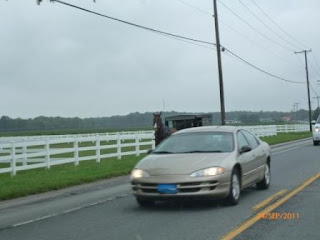When we woke up, we discovered the rain had stopped! Our room looked out on to the canal where there was a reconditioned lighthouse ship, the Overfalls.
We walked the short distance to the ship, which we learned was about to be dedicated as an Historic Monument. Years of work by a group of volunteers to save the ship were finally being recognised.
Next to the ship was a small museum housed in the original 19th century lifeboat station.
We had a delightful talk given by Jim, a volunteer, about the history of the lifeboat service. We were amazed at how they saved sailors from sinking ships by using a cannon to fire a rope to the ship and then hauling each sailor back to land by a hand-winch. In the photo below, you can just see the rack that held the rope, beautifully coiled up in readiness for firing.
Near to our hotel was an original 18th century house called The Cannonball House, so called because of the cannonball embedded in the wall, which was fired during the War of 1812, fought between the Americans and the British.
Today's drive was one of the shortest of our tour, just 120 kms. We left Lewes, pronounced 'Loos', at around 11.30am for the drive north up the eastern coastline of Delaware. Delaware was the first state to sign up to the American Constitution in 1787. We drove through the State Capital, Dover, and past the Old State House.
Leaving Dover, we saw a sign mentioning the Amish, who live in this area. We then saw this typical Amish horse-drawn trap but sadly, as I slowed the car for Wendy to take a photo, another car came between us! Still, you can just see the horse and the top of the trap; better than nothing at all!!
When we reached the state line between Delaware and Maryland, at a place called Marydel, there was this sign to the Mason-Dixon Crownstone placed there when Mason and Dixon were surveying the states at the end of the 18th century. Every five miles they put stones, imported from England, and on each stone there was the crest of the Penns and the Calverts, families who ran the colonies.
We reached Chestertown at around 2pm and checked into The Imperial Hotel located on High Street. As we were starting to unpack the car, who should turn up but our friends, Judy and Tom! It was great to see them again after so many years. Tom has just returned from an assignment to Afghanistan and after we had unpacked, they took us to their house in Chestertown for a bite to eat. We spent a couple of hours talking about his time abroad and also what we have been up to since we last saw them. There was a lot to catch up on!
We walked back from their house to our hotel and, as usual, Wendy took lots more photos. This one is of Chestertown Public School.
Close to our hotel, there was a war memorial site with several stones commemorating the war dead from the First and Second World Wars, the Korean War and the Vietnam War. Then we saw a large granite stone with the names of those who died in the Civil War. On one side were names of the Confederates and on the other, the Unionists. Many of the names on both sides were from the same families, showing how divisive the Civil War was.
Then we saw this stone, erected in 1999 to the memory of the 400 coloured volunteers. They were slaves who received their freedom by enlisting and who had died fighting in the Civil War. They had not been included in the original headstone, which was erected at the beginning of the 20th century.
It's been another interesting and very enjoyable day. Now we have two nights in the same place, a luxury we have not enjoyed since the enforced second night in Port aux Basques, Newfoundland.














How interesting the canon ball is still in the wall! What an interesting piece of history.
ReplyDeleteI love that you saw the horse and buggy. Ohio has a large Amish population too. I will have to tell you my curious story about the Amish from when I was a kid. It's a bit embarrassing!